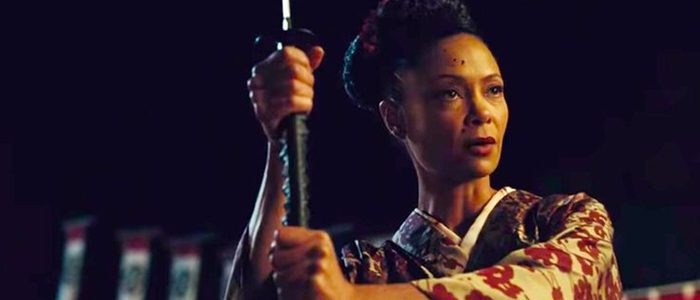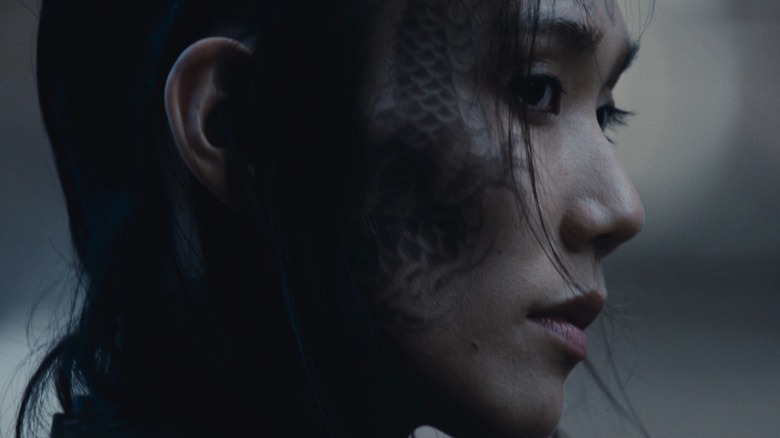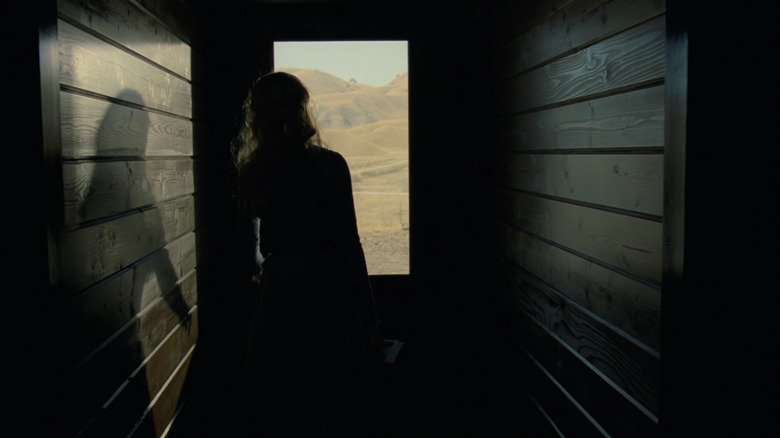How The Parallels Between Westworld And Shogun World Reflect Some Of The Most Famous Movies Of All Time
This week's episode of Westworld, "Akane no Mai," finally walked us into Shogun World, a sister park set in Japan's Edo period. As different as the costumes, culture, and scenery are, viewers looking forward to the introduction of a brave new world, unlike anything we had seen on the show before, may have been slightly underwhelmed by some of the deliberately samey aspects of Shogun World. As our own Chris Evangelista put it in his review: "Shogun World may not be all it's cracked up to be."
The park has noticeable similarities to Westworld and there are two very good reasons for that. To talk about the similarities and how they fit both the story Westworld is trying to tell and its cinematic influences, we'll need to venture into spoiler territory for Westworld, season 2, episode 5.
So unsheathe you samurai swords and let's charge right in like a band of ronin show-watchers in the age of Peak TV.
Through the Looking Glass
Not long after entering Shogun World, "Akane no Mai" places us in a recognizable scenario. Maeve (Thandie Newton), her bandit boyfriend Hector (Rodrigo Garcia), the snake-tattooed Armistice (Ingrid Bolsø Berdal), and their three human captives have themselves been taken captive and led into a Japanese town. There they witness a scene transpire that seems ripped right out of their own programmed past.
It's a robbery, one that harkens back to the oft-repeated robbery that we saw play out at Maeve's Sweetwater saloon and brothel in season 1. Instead of that Old West brothel, however, it's a geisha house where this robbery goes down.
The music — a new arrangement of the recurring "Paint It Black" cover on Japanese instruments (shamisen, koto, taiko drums, and shakuhachi flutes, according to The Wrap) — has already clued us in that we were headed somewhere familiar. And in fact, Armistice comes right out and says, "This all feels a little too familiar." She and Hector notice a gravel butterfly in a small Japanese rock garden outside one building. This reminds them of Maeve's saloon, which held the name "Mariposa"—the Spanish word for butterfly (an allusion to the metamorphosis Maeve would undergo into a self-aware host, the saloon being a cocoon of sorts for her).
Once the robbery starts, Armistice quickly zeroes in on a female Japanese archer, played by Tao Okamoto (The Wolverine). Like her, this archer has a snake tattoo traveling down her neck. "I'll be damned," Armistice says. "It's us."
Shogun World is a mirror image of Westworld – it even makes use of recycled storylines. The show jokes this off by having one of the human captives — Westworld's head of Narrative and Design, Lee Sizemore, played by Simon Quarterman — cop to "cribbing a little bit from Westworld" because he had to write 300 stories in three weeks. Yet the creeping sense of deja vu that the hosts experience when they see their Japanese doppelgängers is not so dissimilar to the feeling a fan of Hollywood westerns might have once experienced when being exposed to certain Japanese samurai films for the first time.
A Pastiche of Different Ideas
Nowadays, it's common knowledge that classic westerns like A Fistful of Dollars and The Magnificent Seven are remakes of Akira Kurosawa films, but imagine you were a Clint Eastwood fan, back in the day, who had no knowledge of this and who landed on Yojimbo one night while channel-surfing.
You might be struck by a similar sense of deja vu as you watched legendary Japanese actor Toshiro Mifune cycle through the same plot beats as Eastwood's Man with No Name in A Fistful of Dollars. In this way, presenting Shogun World as a distorted reflection of Westworld is actually a nod toward the long tradition of cross-pollination between Japanese jidaigeki films (period dramas, including samurai movies) and the genre of the Western.
That includes space westerns like Star Wars: A New Hope, which is rife with Japanese influences. Even The Last Jedi borrows from Kurosawa's Rashomon. A Fistful of Dollars, however, is particularly notable because in that case, the "cribbing" (or plagiarism, for lack of a better word), was so severe that it led Kurosawa to sue Italian director Sergio Leone for delivering an unauthorized spaghetti-western remake of Yojimbo.
Westworld co-showrunner Jonathan Nolan has name-checked Leone's Once Upon a Time in the West as one inspiration for the show. The shot of Teddy (James Marsden) disembarking the train in Sweetwater back in the show's pilot episode was an intentional homage to a shot from that movie. Nolan grew up on Leone's films and was well aware of the Kurosawa connection. In an interview with Entertainment Weekly, he said:
"My older brothers [including Christopher Nolan] and I watched Sergio Leone Westerns and Kurosawa's classic samurai films and were fascinated to discover they had the same plot. You had this wonderful call and response between these two genres — with the gunslinger and the ronin. They have identical tropes but are set within different cultures."
Kurosawa, it should be noted, was influenced by the use of windows and wide-open spaces in the westerns of John Ford; and there are other instances where the inspiration between genres runs both ways, such as the 2013 Japanese remake of Unforgiven, where Ken Watanabe took over the role originated by Eastwood. Westworld's pilot episode also gave us a clear homage to Ford's The Searchers, re-framing the famous shot of a woman's silhouette standing in a doorway looking out on the frontier landscape.
Nolan has called Westworld "a pastiche of different ideas." With Shogun World, the pastiche has now synthesized that "wonderful call and response" between a pair of film genres that inspired him growing up. Yet beyond merely assimilating his own creative influences into the visual fabric of the show, having Shogun World be a mirror image of Westworld also serves an important narrative function.
Making Robots Relatable
Having humans as the main characters in a story is not a prerequisite for making the story relatable on a human level. That said, while Westworld has garnered praise in its second season as it has shifted toward a less mystery-driven storytelling approach, one of the ways it has struggled to connect this season is in the relatability department.
Our previous anchors from the first season, sweet Dolores and nice guy William, have both been unmasked as merciless monsters. William has shown a little more nuance this season (he's not all bad all the time, or at least he was willing to save his sidekick Lawrence's family in last week's episode). But for her part, Dolores is off on an arc now that reminds me of the character Koba in Dawn of the Planet of the Apes (another effective story that was not centered on humans). That character was perhaps best summed up by the quote: "From humans, Koba learned hate. And nothing else." That's about as much substance as Dolores seems to have right now in her bloodthirsty quest against humanity and any hosts she deems unfit to survive, like her beleaguered beau, Teddy.
This has left something of a vacuum to fill in Westworld as we are now watching a show where robots run around in diffuse, Game-of-Thrones-like subplots while humans cower and cuss. Until now, Bernard had been the most relatable character this season, as he has something of a dual nature that sees him interacting with humans and hosts on both sides of the fence. This week, however, made great strides toward establishing the already sympathetic Maeve as a more relatable character, even as she manifested mysterious robot telepathy powers.

What makes Maeve more relatable now is the fact that she herself can become a participant in new stories and find something to relate to in those stories, much like the audience. While the black-hat bandit Hector forms an immediate dislike and distrust of his ronin doppelgänger, Musashi, played by Hiroyuki Sanada (The Last Samurai, The Wolverine), Maeve's motherly instincts see her identify strongly with the geisha Madame Akane, played by Rinko Kikuchi (Babel, Pacific Rim).
The vengeful dance of Akane (or "Akane no Mai") that gives this week's episode its title winks toward Lady Snowblood, which famously inspired Quentin Tarantino's Kill Bill, Vol. 1. But it also winks toward Maeve's backstory, which she relives in traumatic flashes as Akane's daughter lies impaled by a cruel shogun on stage.
Maeve was a character in a story, but now she is awakened to the falseness of that narrative and she is free to write her own story. It's the same arc undergone by Truman in The Truman Show and Neo in The Matrix trilogy (two cinematic works that share much in common with Westworld thematically). Maybe this is why Maeve is becoming increasingly all-powerful: because she's the real robot messiah, not Dolores. No longer stuck in her little loop, but able to form useful alliances with humans, maybe she's the show's true hero.
The best art often affirms some aspect of our own life or world. Westworld is branching out into other parks, but the title of the show is still Westworld, so it's understandable that it would want to use those other parks as a means of reflecting back on characters from the Westworld park. In doing so, it can add a whole new layer to this piece of entertainment about entertainment, even as it continues to frame characters as surrogates for the very audience that consumes that entertainment.


